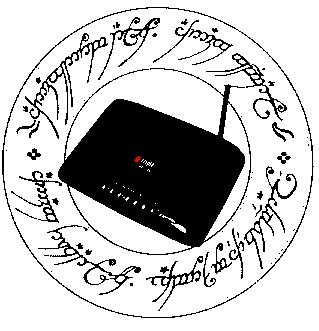One Router to Connect Them All


So at 2:30PM, while I was munching on a bowl of popcorn and watching some brainless action movie in the living room, savoring the odor of the slow cooking meat wafting in from the deck, the phone rings. My wife, Rachel, answers it. I can tell by the level of annoyance in her voice that I'm going to be given the handset any second.
Click on the "Read the rest of this entry" link below for more.
Rachel: It's dad. YOU deal with him.
Me: @#$%! Why do I have to deal with his @#$%^& computer problems all the time? You're perfectly competent!
Rachel: It sounds like something you need to fix. I'm going upstairs to watch the Olympics on the DVR.
Me: @#$%! I grab the handset from my wife. I can feel my baby backs overcooking already. Hey dad, how's it going?
Bob: well, we had some painting done upstairs over the weekend, and this guy came, and we had to unplug a whole bunch of cables from the computer. The Internet doesn't want to come back. I spent a few hours on the phone with Linksys and Cablevision and we can't seem to figure it out. Also we had a power outage the other day and I think something might have gotten zapped.
Me: Well, is the Linksys and the Cable Modem plugged into the surge protector?
Bob: Uh, I think so...
Me: Well, then a power surge probably didn't kill it. Are there lights flickering on the cable modem and the Linksys?
Bob: Yeah...
Me: Okay.... Well, unplug the Linksys and unplug the Cable Modem... plug the Cable Modem back in... wait for all the link stages to come up for a few minutes until you get the amber light on the Surfboard.. then plug in the Linksys.... Wait a minute... Okay try this IP address on the browser... 192.168.1.1. ... okay try Google.. not coming up, okay, lets try it again...
And that's pretty much how the conversation went for about twenty minutes, until I finally figured out that the CAT-5 had been unplugged from the cable modem and it was taking a while for the Cable Modem to come up. Dad's broadband is working fine again, but then it dawned on me, why the hell does this have to be so complicated?
I mean, never mind most people who have a single broadband access device like a lone Cable or DSL modem attached directly to the computer, or a modem and a SOHO router. My own home networking setup is ridiculously complicated. I have a Cable Modem which is attached to a D-Link VOIP router that is supplied to me by AT&T CallVantage, behind which I have a NETGEAR Draft N wireless router set up in a DMZ, which has all kinds of firewall and port triggering/forwarding rules on it, and behind that I have several NETGEAR Gigabit switches going to my servers and desktops.
It seems that every freakin' week, due to some brief Optimum Online service outage or some summer brownout, I have to do this infuriating Infocom-style puzzle sequence (Think "Babelfish" for those of you who remember) where if I don't do it in the correct order and correct timing, my ‘Net connection doesn't come up and I spend about half an hour plugging and unplugging like some frantic 1950's switchboard operator on amphetamines. Can't they put my wireless N router, VOIP router, Gigabit switch, and cable modem all on one box, so the functions are all nice and integrated? I switch one box on and it all works?
Well, it appears that SOHO networking equipment manufacturers used to make stuff like that, but nobody has brought the technology up to date. Motorola has version of the Surfboard with an integrated router, but it's only a Wireless-G, and the hardware hasn't been updated since 2006. CISCO itself abandoned its own, business-class Cable modem gateway routers, and Linksys's integrated Cable Modem product isn't any better than Motorola's. The only manufacturer who seems to be doing any Wireless N integration with broadband at all is NETGEAR, and they only make ADSL-capable converged routers, none of which are Gigabit Ethernet capable PLUS VOIP service integrated.
It seems to me that it would be a good idea for one of the major manufacturers to come up with a "Modular" residential gateway solution. It would consist of a primary router module, which would include 4-port Ethernet hub, two RJ-11 phone jacks for VOIP, two USB ports for external storage/NAS capability and a significant amount of flash memory to allow for plug-in ISV software modules, such as AT&T CallVantage or Vonage VOIP, and 3rd-party firewall suites and customized firmware for vertical applications. The primary Wireless-N router module would have "Snap-in" expansion blocks, such as a DOCISS cable modem, a DSL modem, a fiber module for those lucky to have FIOS, additional Gigabit switch ports or even an additional Wireless-N MIMO module or 3G HSDPA cellular data module (perhaps a PCMCIA slot to accept a standard Aircard?) for a backup wireless data line if your provider goes down or you are actually unlucky enough to live where you can't get cable modem or DSL. This way, you only buy the expansion blocks you need, and it makes for a more universal software/firmware design. One power cord, vastly simplified network setup, integrated software stack and improved performance due to better bus and chipset integration. And ideally, the whole thing should be built on embedded Linux, using a low power processor like an ARM or PowerPC.
I'm sure that a Wireless-N primary module, a gigabit module, a cable modem module and the VOIP software could be all integrated into a single package for less than $200. Are you too looking for better residential gateway integration? Talk Back and let me know.